Japan continues to be excellent. So excellent, in fact, that I’m spending all my time doing things instead of blogging about them. This turns out to be a vicious circle. The more time I spend out exploring Japan the more there is to write about, and the less time there is to do the writing. So unless I start staying up until 3:00 am every night, you’ll just have to take what you get, which is this:
Miyajima is a small island that’s a short train ride and an even shorter ferry crossing from Hiroshima. A UNESCO World Heritage Site, it’s one of Japan’s biggest tourist attractions. It’s famous for the orange torii (shrine gate) of the Itsukushima Temple, which stands out in the ocean in the middle of a small bay. The temple buildings themselves are built on piers so that at high tide the whole complex appears to float. The elevated architecture was meant to keep commoners from stepping onto the island itself, which was considered sacred.
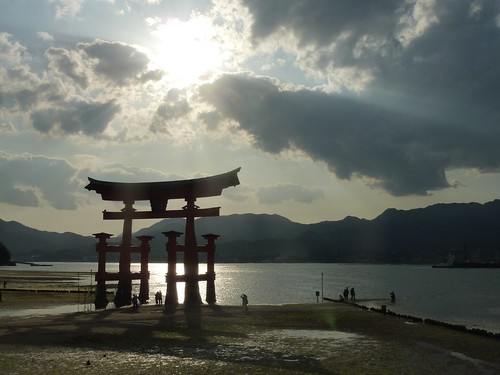 Mandatory shot of the famous gate
Mandatory shot of the famous gate
For a small place Miyajima packs in the sights: there’s the temple and its famous gate (best viewed at both high and low tide), the world’s largest rice paddle, tame deer wandering the streets looking for handouts, an excellent Buddhist temple, a mountain top view reachable by cable car, a main shopping street packed with shops selling the island’s special maple-shaped cakes (momiji mamju), fish sticks, and raw and roasted oysters, and approximately 9,342 Japanese school children. I’m starting to wonder if there are actually any kids actually sitting in classrooms in Japan because everywhere I go they’re there, in huge numbers.
Many people see Miyajima on a day trip from Hiroshima, but I was determined to stay overnight because I wanted to try a real Japanese ryokan (ree-OH-kon), in a nice setting. As the LP says: “Ryokan are often fine old wooden Japanese buildings, with tatami mats, futons, gardens, deep Japanese bathtubs, traditional Japanese service and kitchens that turn out classic Japanese cuisine.” They’ll typically have Japanese decor – along with the tatami mats on the floor, the furniture in the room might be one low table, with minimal wall decoration, and futons that are rolled out for you to sleep on at night. They usually include dinner and breakfast, both in Japanese style, and the good ones will also have their own onsen. Onsen is the Japanese word for a mineral-spring fed hot soaking bath, and visiting a nice onsen is a very pleasant, very Japanese experience.
My ryokan was found for me by Paul and his wife, my personal 24-hour All-Things-Japan Tourist Hotline and Help Centre. They even phoned and made me a reservation. When I arrived I took off my shoes at the door, which is standard practice whenever you’re entering a tatami-matted space. I was greeted by very friendly staff, given a cup of hot water with lemon, and invited to surrender my passport. (This is also standard practice, tatami mats or not; the government apparently requires a copy of the passport be taken at every hotel.) Then I was shown around the important factilities: onsen, massage chairs, beer vending machines. Finally, I got to my room.
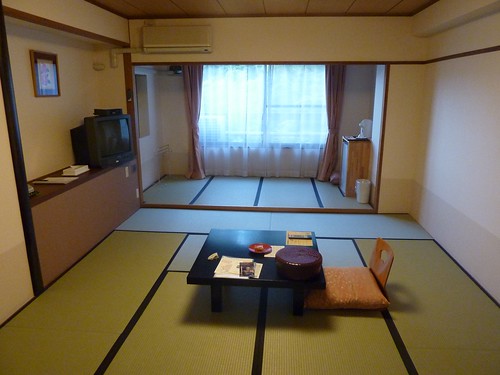 My room, before I got in there and messed it all up, which took 11.3 seconds
My room, before I got in there and messed it all up, which took 11.3 seconds
As you can see, it’s a very minimalist existence. There was the table and the “chair” and that’s about it. There was a small en suite bathroom of a type that have become very familiar to me. I think they’re preassembled and dropped into place in every hotel room in Japan. The bathtub, sink and toilet all seem to be one piece, and they are exceedingly tiny (though not as tiny as the bathroom of my hotel in Jerusalem, but let’s not go there). There was also a closet which contained my yukata, a lightweight cotton robe, and a pair of those Japanese toe socks. The yukata is meant to be worn whenever you want. As Paul says, “…it's perfectly ok to walk around the hotel, sleep, eat dinner, and even explore the neighborhood wearing it.” And in fact, I did see a few people out that evening in yukata. For me, it was enough just to wear it to the onsen.
This ryokan had two sets of onsen (they’re normally divided into men’s and women’s baths). There was an indoor bath and an outdoor one too. I chose to visit the outdoor one, though it turned out not to be outdoors at all, but simply high up in a separate building, and outfitted with a large window that overlooked much of the town. It was actually quite nice to sit in the hot water and gaze out at the sea. From the right angle you could even see the torii, which was cool. I have no pictures of the onsen, and you will probably never get any pictures of any onsen because they’re naked zones. (The fact that I had this one to myself both times I visited is not salient.)
Dinner at the ryokan was amazing. (Yes, I’m going to talk about food some more. Certain elements have – privately – expressed the tongue-in-cheek opinion that much of my blogging has turned into a location-specific preamble that then descends quickly into more food talk. To which I say, “Too bad! 40% of the title of the blog is EAT DRINK, so suck it up!”). So back to dinner. It was a set menu, all very Japanese. I was given a tiny menu card that listed helpful things like “an hors 'd’oeuvre” or “a pot cooked on the table” or “broiled dish”, which was less than illuminating. The presentation, though, was stunning.
 This was the starter course, which was waiting for me when I arrived at my private table
This was the starter course, which was waiting for me when I arrived at my private table
Each course was served by a lovely kimono-clad woman who spoke almost no English, but did give me a glimpse at the English cheat sheet she had for that night’s menu. Therefore I can tell you that the above spread is:
Conger eel and cucumber egg roll
Shrimp dome and paste with botargo
Kimi-sushi (York and mountain root seasoned like sushi) with lotus
Turban shell (sazae) broiled with butter
Conger eel and fish paste with seaweed
and
Horse bean Dengkaku (Horse bean paste with miso)
So that clears things up nicely, right? Well whatever it was, it was great. There was course after course – eight in all – including a nice “mango shimmy” for dessert. I had a couple of beers and rolled myself back to the onsen for a quick soak before bed. And when I got back to the room after dinner, elves had come and made my bed:
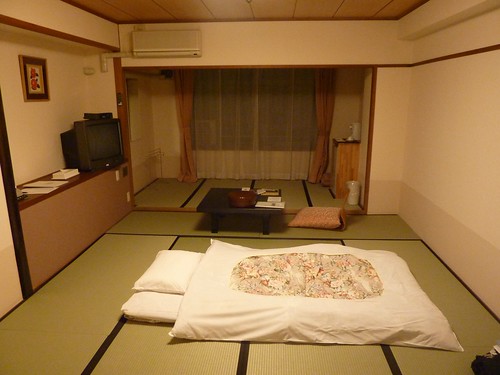 I had to drag everything over towards the wall. Not having anywhere to lean when sitting in bed was just too not right.
I had to drag everything over towards the wall. Not having anywhere to lean when sitting in bed was just too not right.
The futon was quite thin, not at all like what we’re used to in the West, kind of more like a thick quilt. So while it wasn’t as hard as some of the “mattresses” I had in Southeast Asia, neither was it like sleeping on a cloud. I’ve had several nights in a row in tatami rooms now, and though it may seem ungrateful I’m happy to be back in a Western style room where it feels a bit less like camping in an issue of Better Tea Houses & Onsens.
Breakfast at the ryokan was much like dinner – elegant, exquisite, and extensive. It was perhaps a little heavy on the tiny-fish-with-bones and a little light on the Raisin Bran for my tastes, but it was glad to try it once.
And yes, I did see the sights on Miyajima, as enumerated above. By far my favourite was the Daisho-In Temple, which was an afterthought I dropped in to on my walk down the mountain. It was a long walk, but I put the time to good use with my Lonely Planet Japanese Phrasebook. I’m now mostly ok with the numbers, and I can request a table for one, and ask for a beer politely, so I’m basically set.
Daisho-In is a Buddhist Temple with a few really nice features, one of which was an excellently informative free colour pamphlet in English explaining many of the temple precinct’s most interesting features. There was a lovely dark room, the Henjyokutsu Cave, which houses copies of the principle Buddhist Icons one would encounter on the famous 88 Temple pilgrimage route on the Japanese island of Shikoku. Apparently worshippers believe that passing by all 88 of the images in the cave on Miyajima will give them the same blessings as those who trudge the entire 1,200 kilometer route to see the original 88 statues on Shikoku. This seems like a raw deal for the walkers, but at least the cave was interesting and photogenic, especially the lanterns hanging in rows on the celiing.
 The lanterns that dimly illuminate Henjyokutsu Cave
The lanterns that dimly illuminate Henjyokutsu Cave
However, my favourite part of the temple was the 500 Raken Statues. On a side path up the steps to the temple, I entered a little garden area that with 500 individual statues of disciples of Shaka Nyorai, another name for the Buddha. The little statues were about 18” high, and each has a different facial expression. They line the path up to the temple, and were such fun to look at that the time passed more quickly than I realized and they ended up closing the gate behind me, so I had to let myself out of the temple grounds and make my way back to the ryokan.
Miyajima was a good stop. Even though I was only there for one night I saw all the major sights on the island and had time for two trips to the onsen, and to sample three different flavours of the momiji cakes (chocolate, almond and deep-fried custard cream), and to try the fish cakes and the oysters. And I took my picture with the world’s largest rice paddle, watched local people clamming at low tide, walked around the town after dark, and tried the massage chair at the ryokan. And let me tell you, plonking yourself down in a massage chair (with calf-massaging leg rests) when the controls are entirely in Japanese is no simple thing. There’s a lot of trial and error involved, and much pummeling of kidneys.
So like I said, Japan continues to be excellent. I feel like I could write a whole blog just on what I see when I walk down one block. Or visit one supermarket. Or take one trip on the train. There’s so much to see and do, really you should stop relying on me to tell you what it’s like and come have a look for yourself.

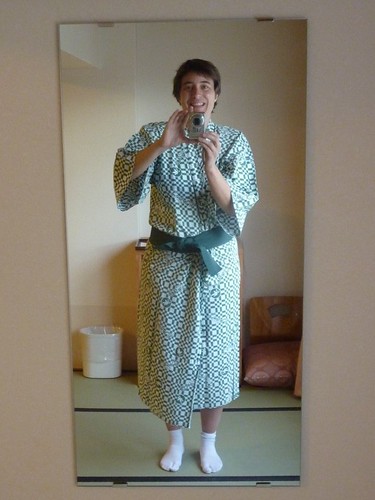
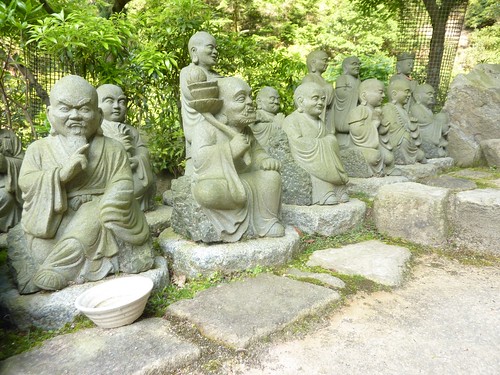


5 Comments:
Keep the mouth-watering food descriptions coming.
Enjoy your last couple of weeks.
Happy Trails...
rh
I personally fully support the food journaling! I used to keep a travel diary and it devolved into a food diary after 1 trip. I keep business cards of all the restaurants we've been to and descriptions of everything we ate. It's a great memento and I have used it MANY times to recommend restaurants around the world to my travelling friends.
Your descriptions of Japan are amazing and I really want to go!
Uh, you had me at "...raw and roasted oysters..." ;)
For my money, a futon on tatami is the most comfortable sleeping surface ever invented....but to each her own. :)
Nice to know you're enjoying the Japan part of this trip! Your comments confirm my feeling that it's one of the world's most interesting places to visit (and I haven't been around the world yet).
Ohhhh the oysters in Miyajima! SO. GOOD.
Post a Comment